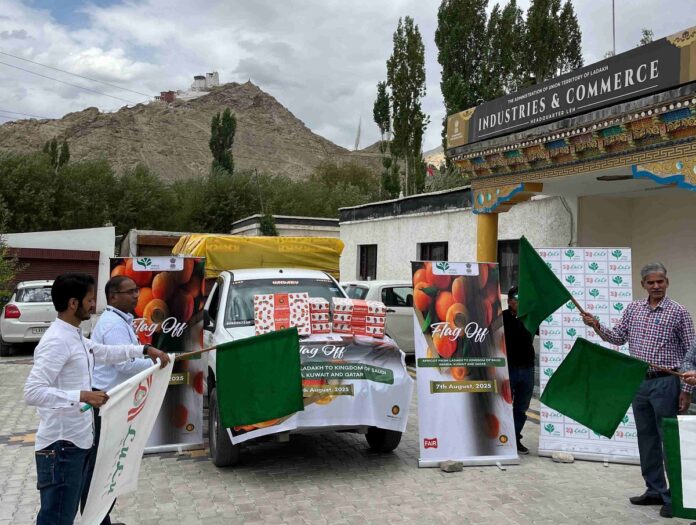Famous for their rich sweetness, organic purity, and heritage value, Ladakh’s apricots are slowly making their way from remote Himalayan orchards to international shelves. The prized ‘Raktsey Karpo’ variety, which bagged the region’s first-ever Geographical Indication (GI) tag in December 2022, is at the heart of this push.
Spread over 2,612 hectares, Ladakh’s high-altitude orchards produce nearly 15,868 metric tonnes of apricots annually — two-thirds from Kargil and the rest from Leh. Yet, for all their premium quality, exports have remained modest, with domestic demand now absorbing the bulk of the harvest.
Exports to the Gulf – and a Push for More
Recently, the Union Territory’s Department of Industries and Commerce, in collaboration with the Agricultural and Processed Food Products Export Development Authority (APEDA), flagged off 1.5 metric tonnes of fresh Halman apricots for Saudi Arabia, Kuwait, and Qatar. The move is part of the Mission Bal Bharari initiative to showcase Ladakh’s agricultural products globally.
Rudra Goud PT, Secretary of Industries and Commerce, said:
“We will be looking at exporting to more geographies in the future through APEDA. As you are aware, fresh apricots have a very short shelf life, so there is a need to improve logistics in terms of cold chain and related infrastructure. There is also a need for value addition and processing of apricot and seabuckthorn products.”
He added that the horticulture department is addressing logistics challenges with subsidies, but more investment is needed:
“The UT of Ladakh has great potential for unique products like apricots and seabuckthorn, and we will work on increasing exports of both fresh and processed produce to more markets.”
Domestic Market: The Real Driver

While exports make headlines, the domestic market is now a major revenue source. Dr. Tsering Stobdan, scientist at the Defence Institute of High Altitude Research (DIHAR), explained:
“Even in terms of exports, we are not doing much at present; most of our products go to the domestic market. Either way, whether it’s the domestic market or exports, farmers earn almost the same.”
Ladakh’s premium apricots — Halman and Raktsey Karpo — stand out for their high sweetness, with Total Soluble Solids (TSS) levels of about 25% and 28% respectively. “Plus, our apricots are 100% organic,” Dr. Stobdan said.
The short harvest window — mid-July to mid-September — limits storage but ensures freshness. The high altitude extends ripening compared to other states, giving Ladakh a seasonal market advantage. “Most apricot imports to India happen in May–June, whereas Ladakh’s harvest is in July–August. We don’t have much competition because of this,” he noted.
A Stop-Start Export Journey
Ladakh’s export journey began in 2021, when 20 metric tonnes were shipped to Dubai. In 2022, 35 metric tonnes went to Singapore, Mauritius, and Vietnam. But in 2023–24, bad weather and poor fruit quality halted shipments.
Dr. Rigzin Tsewang, Business Development Manager, APEDA Ladakh, said:
“In 2024, we exported 100 kilograms of freeze-dried apricots to London on a trial basis. In 2025, to promote fresh apricots in new markets like Saudi Arabia, Kuwait, and Qatar, we exported 1.5 metric tonnes.”
For exports, quality is paramount. “We harvest at 70–80% maturity for distant markets. All apricots are hand-harvested to avoid damage, packed in 4-kilogram boxes, pre-cooled for 24 hours, and then exported,” Dr. Tsewang said.
Costs and Competition
Despite growing awareness, Ladakh’s apricots face pricing challenges. “The global market has apricots from many countries that are cheaper than ours. We are still in the initial stage and don’t have large, organised orchards,” Dr. Tsewang explained. Collection from multiple villages, high manual labour, and transport costs push prices up.
Pricing fluctuates with fuel and logistics costs, and quality grading is critical. “The price also depends on the fruit’s quality, size and the area it comes from,” he said.
For Zakir Hussain Zaidi, CEO of Halman Apricots Kargil, building an export-ready supply chain starts at the orchard.
“At present, the productivity of apricots is good, but the problem is that our people do not treat it as a business. We pay Rs 120 per kilogram and bear the labour cost. The farmer only has to take us to the orchard; we do everything else.”
Fruits are hand-picked, with overripe ones reserved for sun-drying. Key sourcing areas include Gurgurdo, Batalik, Darchiks, Garkhon, and Gonma in Kargil.
Heat was once a major hurdle.
“In the evenings, the temperature in the Batalik and Sham belts can be 35°C. During packaging, the ripened apricots would become overripe due to the heat,” Zaidi recalled.
Working with food scientists, the company introduced pre-cooling, dropping temperatures to 4°C — “a shock therapy” that preserves freshness.
Breathable packaging, with airflow holes, now extends shelf life. But Zaidi is clear:
“The biggest problem is that we do not have the post-harvest technology we need, such as pre-cooling facilities, drying technology and pulping technology.”
From 58 tonnes exported so far to an expanding domestic presence, Ladakh’s apricot industry is at an inflection point. As logistics, processing, and market access improve, the Himalayan fruit could see its GI tag backed by global recognition.
Or, as Dr. Stobdan puts it:
“Earlier, we didn’t focus much on apricots, but the future holds huge potential.”








